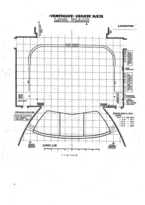VanemuineTheatre, Little Building
alias State Theatre VanemuineVanemuise 45a | |
| show on the map | http://www.vanemuine.ee |
Important events
People
History
As an institution, the Vanemuine Theatre in Tartu is the oldest Estonian theatre: it was established in 1870. The Little Building, hosting the theatre today, was erected from 1914 to 1918 at the commission of the German Craft Association. The theatre was designed by Arved Eichhorn at a time when Art Nouveau was popular. In Germany this style was influenced by Neobiedermeier and Heimatkunst.
Characteristic elements of these styles can be found both on the façade and in the interior of the theatre. The building was renovated between 2013 and 2014. Today, the main façade in the Art Nouveau style presents itself most beautifully against the background of trees in the nearby park.
Teater Vanemuine, Vanemuise väike maja • Vanemuise 45a • 51003 Tartu • Estonia • Tel.: +372 7440 100 •teater(at)vanemuine(dot)ee • www.vanemuine.ee
Visits: by appointment
Tourist information
Tel.: +372 744 2111
tartu(at)visitestonia(dot)com
www.visittartu.com
The Vanemuine, named after the old Estonian god of music and poetry in the romantic pseudo-mythology of 19th-century national awakening, is the oldest Estonian theatre. It was born in 1870 within an amateur singing and acting society in the old university centre Tartu, which at present has ca 100,000 inhabitants and is the second-largest city in the country.
After the successful architectural competition for the Tallinn German Theatre (The Drama Theatre) in 1906, Tartu German Handicraft Association also decided to restart the plan to build a new stone theatre house. They ordered projects for the new theatre house already in 1904 - stone as well as wooden versions - but due to the events in 1905 the plans were set aside. The competition was finally launched in 1908, at the same time with the theatre Estonia in Tallinn and it was to be a 600-seat theatre hall with one balcony, it had to have a wide semi-circular hallway with wardrobes, a little foyer and a vestibule. It wasn’t intended as a grand project.
The competition had a lot of interest and altogether 53 projects were submitted. The jury comprised Johannes Koch and Otto Hoffmann from Riga and Aleksander Hammerstedt from St Petersburg (this time there were no Finns) and they liked best the project by Berlin architects Ernst Hoffmann and Fritz Schulz. The second prize went to Nikolai Vasilev and Aleksei Bubyr, who also designed the Tallinn German Theatre and the third prize to Hermann August Hartmann from Riga. The honorable mention was given to the compact spatial project by Chemnitz (for a while also known as Karl-Marx·Stadt) architects Burger and Benirschke. It was evident that German style and mind was preferred and it was also quite understandable. Vasilev’s and Bubyr’s project was praised for the original exterior solution of the building, its Art Nouveau forms made it very different from other projects. The St Petersburg architects evidently didn’t know about the rather closed-in atmosphere and prevailing German taste in Tartu.
The building of the theatre progressed quite slowly and when it finally started to advance again, the Tartu town architect Arved Eichhorn was given the assignment to design a smaller version of the first prize project. In 1914 the project got confirmation and now had a 550-seat theatre hall. It seems that in addition to the first prize project Eichhorn also used details from Burger’s and Benirschke’s work – the high pilasters, the narrow staircase windows that grow shorter step-by-step and the shape of the stage tower. The end facade was changed during construction – initial project had one big window and a wide balcony, but three high and narrow windows were built instead. Also the Eichhorn designed arch-doors were replaced with ordinary ones.
The Tartu theatre was built during the times when Neo-Biedermeier style gained popularity in Germany, inspired by the nationally rooted Heimatkunst and also soundly positioned classicism. Although many competition projects were still in Art Nouveau style, the retrospective angle was evident in the executed projects. The end side of the building acts as the main facade with its curved edge extending outwards, divided by pilasters and high windows. The composition is completed by baroque pediment with festoon and an oval window in the middle, and a high curb roof. The cornice below the roof is embellished with festoons. Neo-Biedermeier was essentially chamber-like style and suited well for a small theatre in Tartu.
When the theater was festively opened on 19 October 1918, the local German press welcomed the new building as a symbol of German culture, “making homeland truly feel like homeland.” The theatre hall was considered tasteful in every way, “This yellow-and-white-coloured room has a subtle intimate feel, that creates just the atmosphere for a sensitive enjoyment of art. This is also accommodated with the virtue that there is no place in the hall where the scene on the stage wouldn’t prevail.” Also the small but “exceptionally cozy and elegant” foyer was praised.
The new theatre was positively received also by the local daily newspaper Postimees, “We can state with satisfaction that our homeland has become richer with this new beautiful building and we hope for the future that its flowing energy will carry our people’s noble ideas in our homeland.”
Literature:
- Carritt G., Estonian Music, „The Musical Times” 76 (1935).
- Mansbach S. A., Modernist Architecture and Nationalist Aspiration in the Baltic. Two Case Studies, „Journal of the Society of Architectural Historians” 65 (2006).
Tags: Art Nouveau
Author: Hallas-Murula Karin
Additional information
No information has yet been entered
Add information










